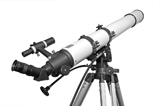Unit C
1. Unit C
Unit C Introduction

© 2009 Jupiterimages Corporation

© Peter Guess/shutterstock

© Stephen Firmender/shutterstock

© 2008 Jupiterimages Corporation

© John Keith/shutterstock

© Adrian Matthiassen/shutterstock

© Eremin Sergey/shutterstock

© Ioana Drutu/shutterstock

© James Steidl/shutterstock
In Unit C you will learn about the nature and behaviour of electromagnetic radiation (EMR). You will interpret experimental evidence to reveal our current understanding of EMR as it relates to wave-particle duality and, ultimately, the basic concepts of quantum theory. You will examine how electromagnetic radiation also helps us understand our universe and how it is used everywhere in society. For example, electromagnetic radiation is generated and/or used by cell phones, microwaves, lights, X-ray machines, satellites, stoves, televisions, solar panels, and so on.
In Module 5 you will explore the electromagnetic spectrum and learn about the wave nature of EMR. You will build on the wave theory you learned in Physics 20 by examining how the wave nature is supported by reflection, refraction, and diffraction in the context of optical systems, such as lenses for telescopes and microscopes; CDs, DVDs, and Blu-rays; and fibre optics.
In Module 6 you will learn about the particle nature of EMR and see how blackbody radiation, the photoelectric effect, the Compton effect, and de Broglie’s matter wave experiments led to the wave-particle duality of light. This module shows the transition in thinking from Newtonian classical physics to modern quantum physics and how that has influenced technology and our daily lives.
At the end of this unit, you will understand the behaviour and the nature of electromagnetic radiation in both natural and technological applications. Furthermore, you will understand these applications in relation to quantum theory.
Specifically, at the end of the unit you will be able to explain:
- the role of electricity and magnetism in the production of EMR
- the wave and particle characteristics of EMR
- how EMR is applied in technological devices that produce or use EMR
- the photoelectric effect and how it supports the concept of the quantum
- the wave-particle duality of light and how it is supported by experimental evidence